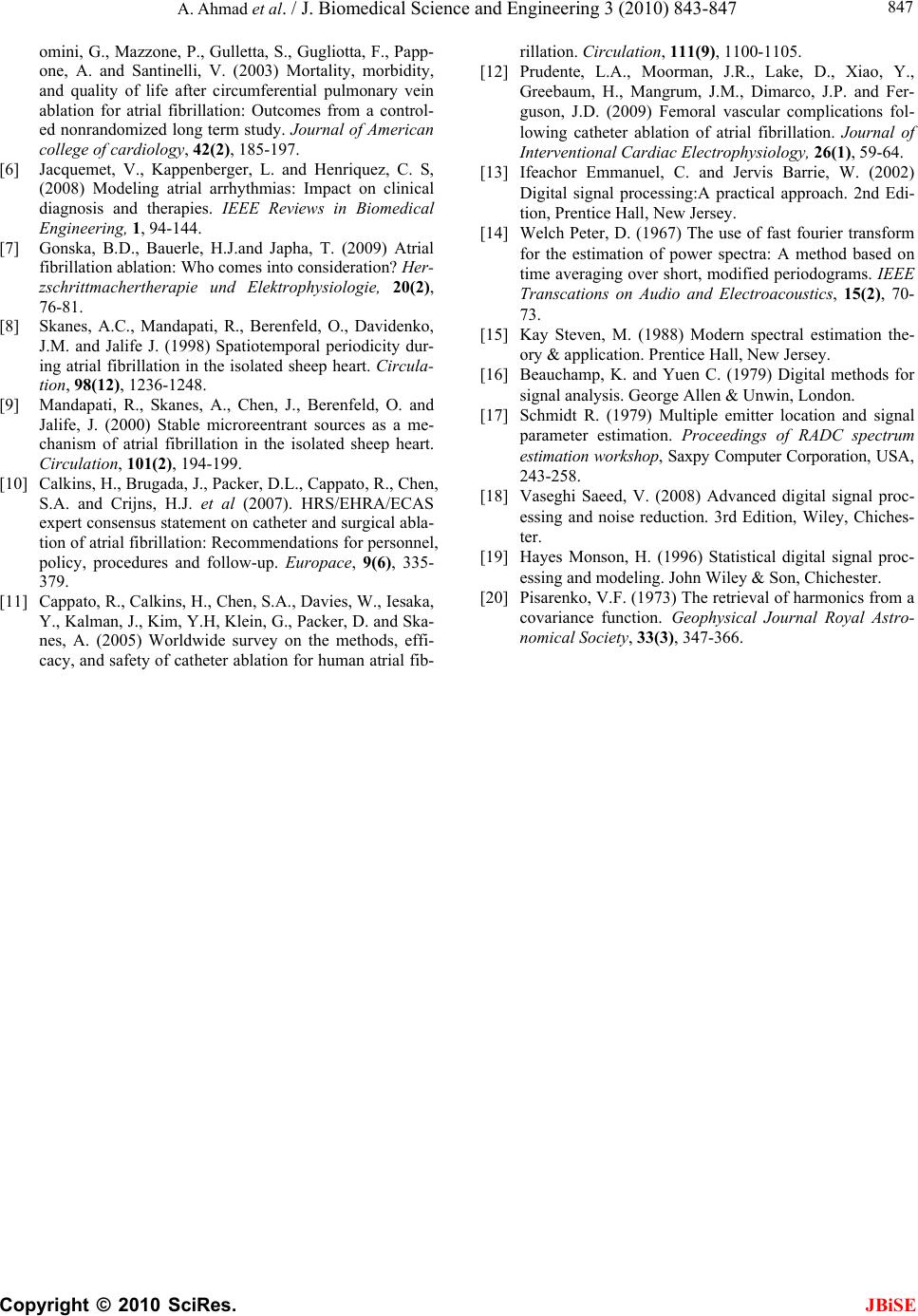
A. Ahmad et al. / J. Biomedical Science and Engineering 3 (2010) 843-847
Copyright © 2010 SciRes.
847
JBiSE
omini, G., Mazzone, P., Gulletta, S., Gugliotta, F., Papp-
one, A. and Santinelli, V. (2003) Mortality, morbidity,
and quality of life after circumferential pulmonary vein
ablation for atrial fibrillation: Outcomes from a control-
ed nonrandomized long term study. Journal of American
college of cardiology, 42(2), 185-197.
[6] Jacquemet, V., Kappenberger, L. and Henriquez, C. S,
(2008) Modeling atrial arrhythmias: Impact on clinical
diagnosis and therapies. IEEE Reviews in Biomedical
Engineering, 1, 94-144.
[7] Gonska, B.D., Bauerle, H.J.and Japha, T. (2009) Atrial
fibrillation ablation: Who comes into consideration? Her-
zschrittmachertherapie und Elektrophysiologie, 20(2),
76-81.
[8] Skanes, A.C., Mandapati, R., Berenfeld, O., Davidenko,
J.M. and Jalife J. (1998) Spatiotemporal periodicity dur-
ing atrial fibrillation in the isolated sheep heart. Circula-
tion, 98(12), 1236-1248.
[9] Mandapati, R., Skanes, A., Chen, J., Berenfeld, O. and
Jalife, J. (2000) Stable microreentrant sources as a me-
chanism of atrial fibrillation in the isolated sheep heart.
Circulation, 101(2), 194-199.
[10] Calkins, H., Brugada, J., Packer, D.L., Cappato, R., Chen,
S.A. and Crijns, H.J. et al (2007). HRS/EHRA/ECAS
expert consensus statement on catheter and surgical abla-
tion of atrial fibrillation: Recommendations for personnel,
policy, procedures and follow-up. Europace, 9(6), 335-
379.
[11] Cappato, R., Calkins, H., Chen, S.A., Davies, W., Iesaka,
Y., Kalman, J., Kim, Y.H, Klein, G., Packer, D. and Ska-
nes, A. (2005) Worldwide survey on the methods, effi-
cacy, and safety of catheter ablation for human atrial fib-
rillation. Circul ati o n, 111(9), 1100-1105.
[12] Prudente, L.A., Moorman, J.R., Lake, D., Xiao, Y.,
Greebaum, H., Mangrum, J.M., Dimarco, J.P. and Fer-
guson, J.D. (2009) Femoral vascular complications fol-
lowing catheter ablation of atrial fibrillation. Journal of
Interventional Cardiac Electrophysiology, 26(1), 59-64.
[13] Ifeachor Emmanuel, C. and Jervis Barrie, W. (2002)
Digital signal processing:A practical approach. 2nd Edi-
tion, Prentice Hall, New Jersey.
[14] Welch Peter, D. (1967) The use of fast fourier transform
for the estimation of power spectra: A method based on
time averaging over short, modified periodograms. IEEE
Transcations on Audio and Electroacoustics, 15(2), 70-
73.
[15] Kay Steven, M. (1988) Modern spectral estimation the-
ory & application. Prentice Hall, New Jersey.
[16] Beauchamp, K. and Yuen C. (1979) Digital methods for
signal analysis. George Allen & Unwin, London.
[17] Schmidt R. (1979) Multiple emitter location and signal
parameter estimation. Proceedings of RADC spectrum
estimation workshop, Saxpy Co mputer Corporation, U SA,
243-258.
[18] Vaseghi Saeed, V. (2008) Advanced digital signal proc-
essing and noise reduction. 3rd Edition, Wiley, Chiches-
ter.
[19] Hayes Monson, H. (1996) Statistical digital signal proc-
essing and modeling. John Wiley & Son, Chichester.
[20] Pisarenko, V.F. (1973) The retrieval of harmonics from a
covariance function. Geophysical Journal Royal Astro-
nomical Society, 33(3), 347-366.